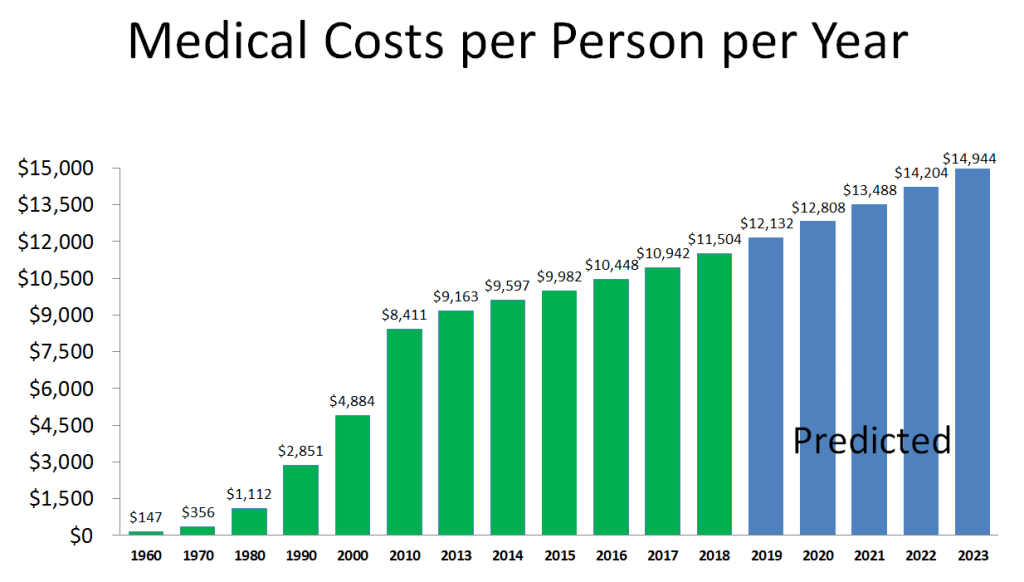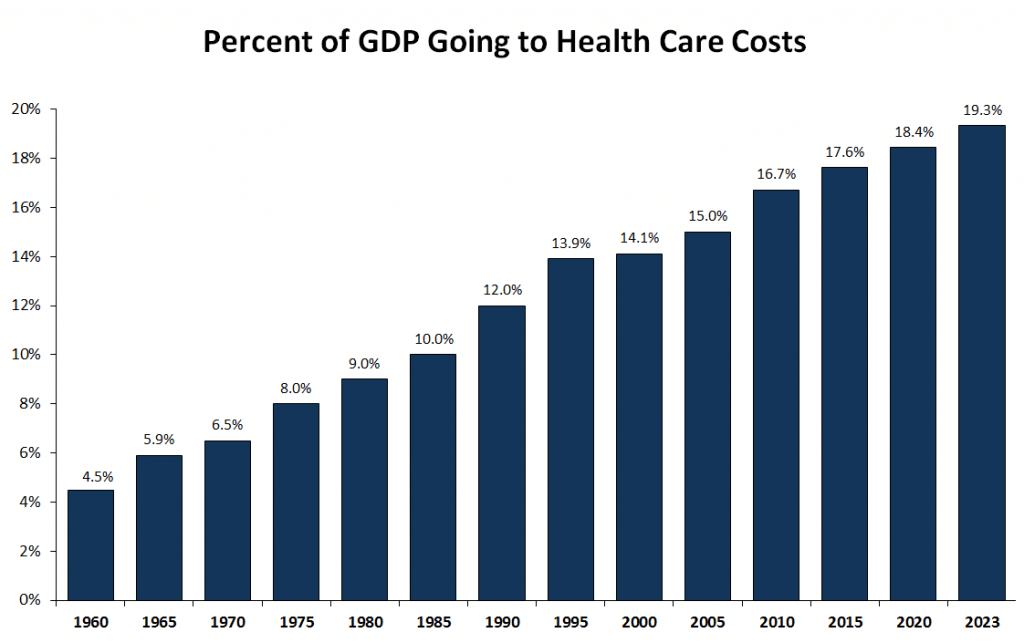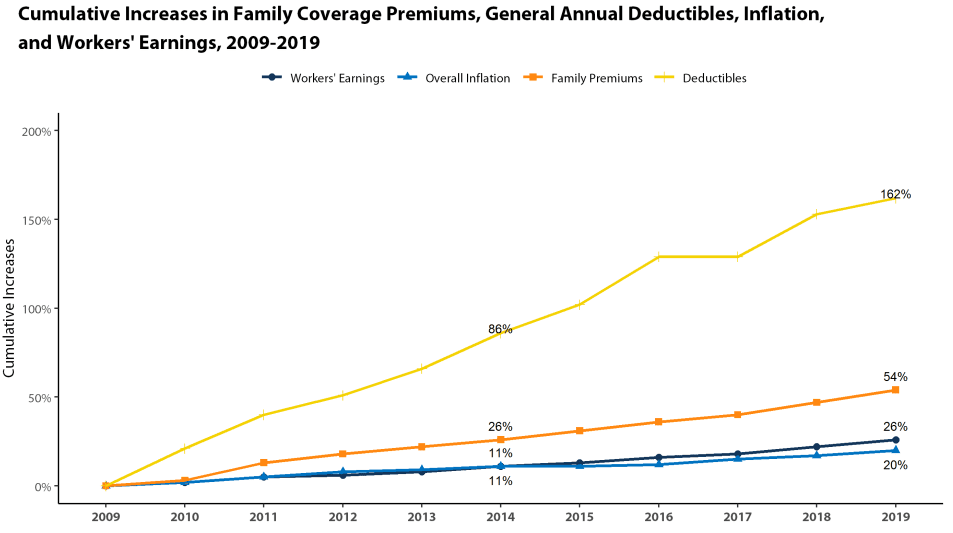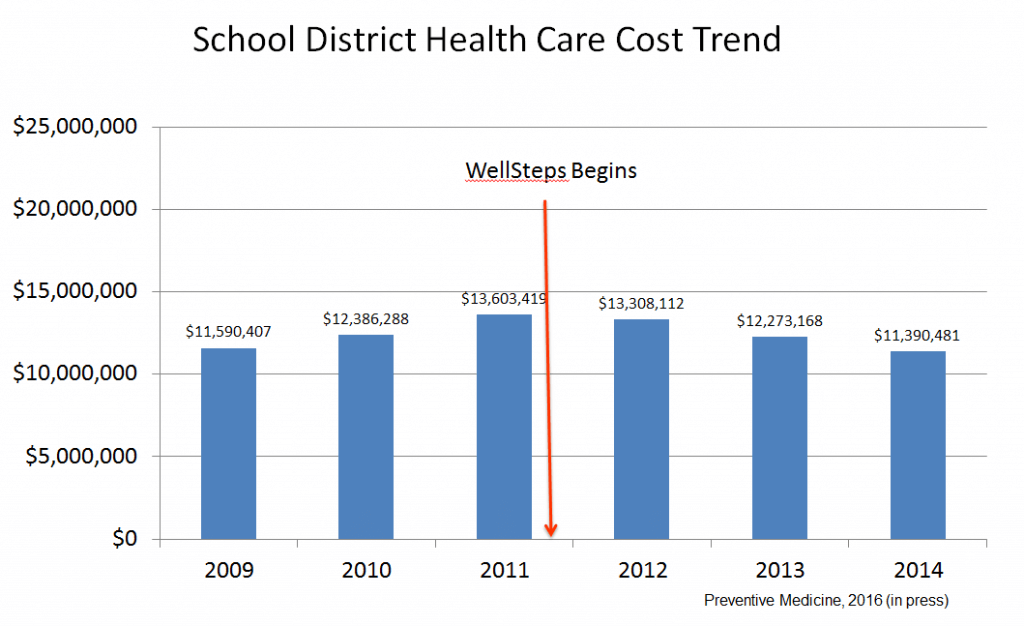Health and wellness in the workplace is crucial. Elevated healthcare costs are the biggest single risk most employers face. This requires employers to implement many different cost containment strategies such as offering high deductible health care plans, changing insurance carriers, reducing benefits, cost shifting, ceasing to offer a health plan, and offering worksite wellness programs.
3 Charts That Make the Case for Workplace Wellness
Here are three charts that show why employee wellness programs are important and here to stay. Kaiser Family Foundation data on healthcare costs per person per year in the United States shows that costs have increased every year.
The Cost of Medical Care Only Goes Up
Presently, the United States is spending just under $10,000 per person per year in healthcare costs.

This is an average across every person in the United States. Going forward, it is predicted that costs will continue to increase, reaching almost $15,000 per person per year in the year 2023. Employers and employees will have to decide who will be paying for this added cost. However, worksite wellness programs can help companies to slow this trend.
Health Care Costs Are a Huge Part of Our Entire Economy
There is a different way to look at this cost. The gross domestic product is a measure of how much the United States produces. For example, 3.5% of everything the U.S. produces is created to support the U.S. military.
Said another way, for every $100 worth of stuff that is produced in the U.S. $3.50 of those $100 was spent on the military. In the 1960s, about 5% of everything that was produced in the U.S. was associated with health care.

Every year since then, the portion of our entire economy that is devoted to paying the cost of health care has increased. Projections show we are quickly closing in on 20%.
Soon approximately $20 of every $100 of production in the U.S. is associated with the cost of providing health care. As you can see from this graph it appears that this trend will continue indefinitely.
Perhaps someday in the future, 100% of all that is produced in this country will be tied to the healthcare system. At that time, every man, woman, and child in the United States would be a doctor and we would take turns treating and billing each other.
Obviously we are never going to reach that point because we have to do something else in this country besides spend money on health care. But the point is that the cost of health care has become one of the largest single expenses that exists in the United States today.
Cost of Health Care Outpaces Everything
And, if you look at past trends it is pretty easy to predict that the cost is likely to increase in the future.
The increasing cost of health care is particularly painful for employees. This last chart shows four sets of data.

The bottom line represents the rate of inflation we have experienced over the last 10 years. In that time, the costs of goods and services that we all pay for has increased about 20%. During that same time the increases in salaries and income we have all experienced have been slightly more than that, or about 26%.
These two bottom lines show that inflation is real and that things cost more in the future than they did in the past and our earnings are just barely staying ahead of the increased cost due to inflation. The top line in this chart shows the increase in the cost of our health insurance premiums over the same time.
Over this same time period the cost of medical insurance premiums and deductibles have increased 54% and 162% respectively. Our income/earnings have failed to keep up while the cost of our insurance premiums and deductibles have soared.
No wonder people are complaining about the cost of health care. No matter how much we earn we can’t keep up with the costs of health care. This is why implementing health and wellness in the workplace is so essential.
What Wellness Program Options Do Employers Have?
The struggle that many employers face is to decide who is going to pay this difference. Should the employers pay for the increased cost or should they pass the increased cost of health care on to their employees. Working Americans feel the pain associated with high healthcare costs when we bring home less money.
Besides the cost reduction strategies mentioned above, employers can reduce the demand for healthcare services by helping employees improve their health. This is where the impact of effective worksite wellness programs comes into play.
Public health models tell us that poor lifestyle behaviors lead to elevated health risks like high blood pressure, high blood cholesterol, and high blood glucose.
These elevated health risks eventually lead to expensive and deadly chronic diseases. Health and wellness in the workplace can improve employee health behaviors and lower health risks can reduce the incidence of chronic diseases such as heart disease, cancer, stroke, and diabetes. These are the most expensive diseases to treat and these diseases are almost exclusively lifestyle related.
There is no question that a well-designed worksite wellness programs can improve employee health and impact employee healthcare costs. But they cannot reverse the ever increasing costs associated with healthcare services.
Worksite wellness programs can dramatically improve employee health and they can bend the healthcare cost trend, but they are not a long term solution to combat sustained upward cost pressure.
This is because of the fact that poor employee health is just one of the many factors that explain why the cost of healthcare is so high and continues to rise.
Health and Wellness in the Workplace Makes a Difference
In 2015, we published a research paper and a white paper on the impact of a health and wellness program on a large employer located in the Western United States.
After three years of an aggressive worksite wellness effort, we documented clear improvements in employee health, reductions in health risks, and improvements in productivity.

This last chart shows this employer’s actual healthcare costs per year for three years prior to and three years after implementing an effective worksite wellness program. The worksite still spends between 11 and $13 million a year to provide healthcare services for their employees but over the six-year period of this study, healthcare costs did not increase.
Other worksites and organizations in the same geographical area experienced dramatic healthcare cost increases during the same time. This is just one reason why wellness programs are important.
Can Worksite Wellness Really Make an Impact?
The three graphs above show us why health and wellness in the workplace is important. They provide clear evidence that the cost of healthcare in the United States has and will continue to increase at an unsustainable rate.
Employers will do everything they can to control that cost, but more and more are passing the cost increases along to their employees. Many of the real drivers of healthcare costs are beyond the scope of worksite wellness programs, but worksite wellness programs can reduce the demand for healthcare by improving employee health.
The cost of healthcare is going to continue to increase. The only real question employers have to face is what they will do about it.
Employee Wellness FAQs
What is workplace health and wellness?
Worksite wellness programs can be defined as any health promotion effort supported by the employer. This may be done internally or through a vendor. If you would like to learn more about the wellness programs offered by WellSteps, please click here. For ideas on how to better the health of your employees, see this blog post. There are many reasons to promote wellness at the workplace. In this article we discuss the financial benefits. However, many corporate wellness programs exist as a perk for employees or to improve morale.
Why is health and wellness important to employees?
Health and wellness is important to everyone. When people are healthy, they feel better, their quality of life increases and they live longer! Employers can show that they care by taking an interest in their employees’ health.
One WellSteps client showed the importance of employee wellness when they said this: “Since starting WellSteps, we have been far more active in the office! Everyday a large group will use a part of their break and we walk 2 miles at the park. I have lost 12 pounds in the last 3 months, and my coworkers are shedding pounds as well! Not only are we feeling good, our team morale has increased too! Can’t wait to see where this journey takes us!”
What are the benefits of health and wellness?
To see a detailed review of worksite wellness benefits, check out this blog post. Some of the main benefits are:
Positive changes in employee health behaviors
A decrease in elevated health risks
A reduction in health care costs
An increase in productivity and a decrease in absenteeism
High employee morale, which leads to better retention and recruitment
